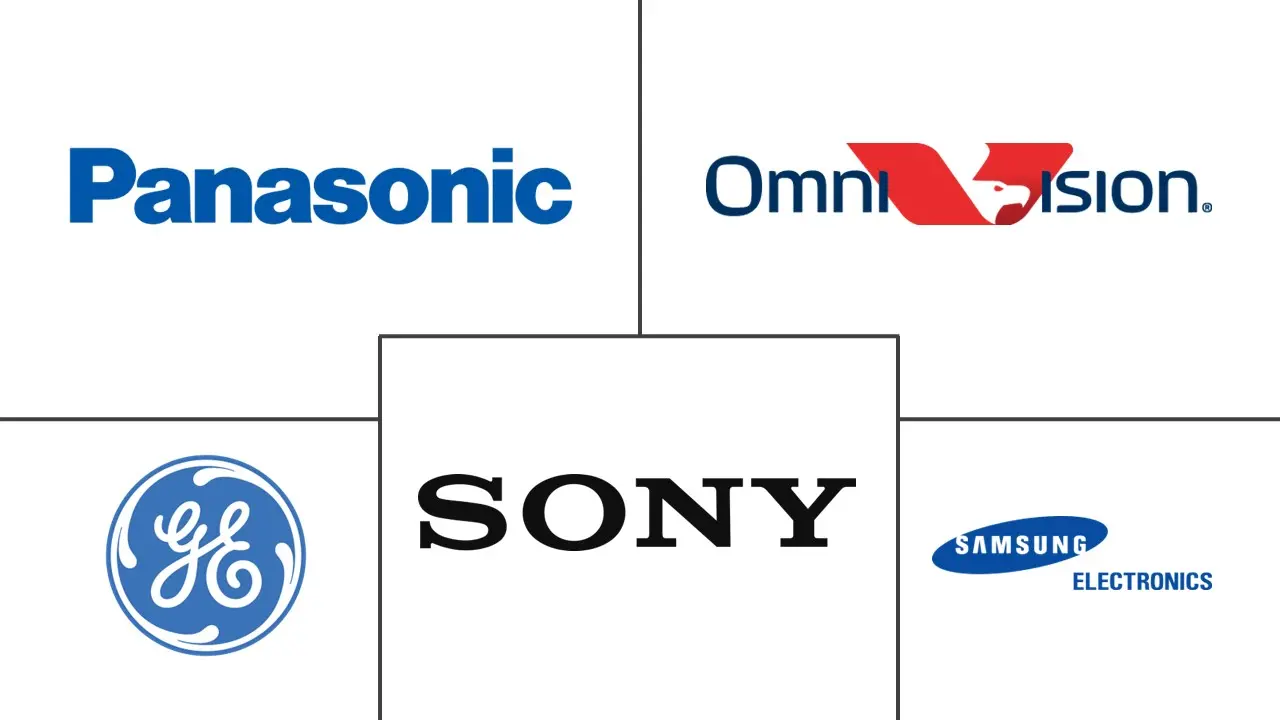Asia-Pacific Optoelectronics Market Size and Share
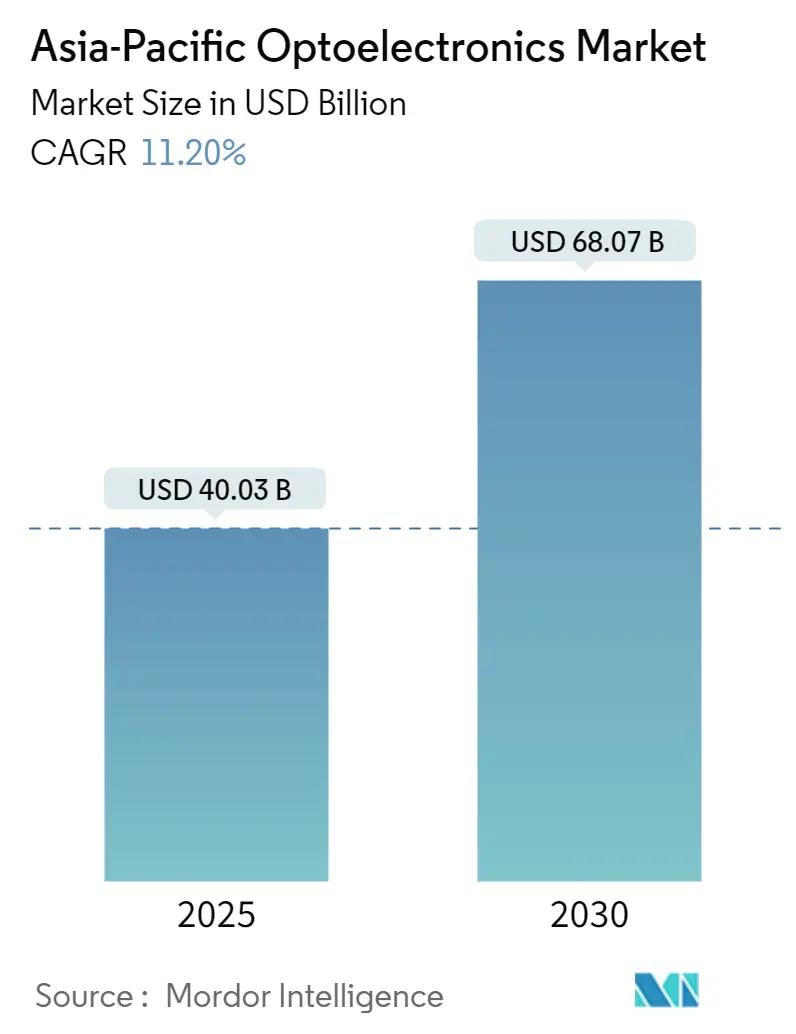
Asia-Pacific Optoelectronics Market Analysis by Mordor Intelligence
The Asia-Pacific Optoelectronics Market size is estimated at USD 40.03 billion in 2025, and is expected to reach USD 68.07 billion by 2030, at a CAGR of 11.2% during the forecast period (2025-2030).
- The increasing adoption of advanced manufacturing and technologies drives the demand for optoelectronic elements in the industrial sector using laser and machine vision systems. According to the Ministry of Science and Technology, the Indian government has set a growth target of 16% of GDP for the manufacturing sector to 25% by 2025. The National Manufacturing Policy and the emphasis on "Make in India" are effective economic development strategies.
- Optoelectronics components are semiconductor devices that can either produce light or can react to it. The demand for optoelectronics increases in the region due to increased demand for smartphones and consumer electronics. Furthermore, promotive government policies and cheaper availability of labor and resources have led to the region being the center for semiconductor production and, thus, will grow substantially fast in the coming years.
- According to the National Bureau of Statistics of China, in December 2022, the production volume of cell phones in China amounted to around 143 million units, a slight increase from the previous month. In addition, the number of cell phone subscribers in China reached about 1.66 billion in June 2022, displaying a growth momentum of a few million subscribers each month, which may further propel the studied market growth.
- Furthermore, vendors in the market are focused on investing in medical investments. In November 2022, Integrated Endoscopy launched NUVIS Single-Use Arthroscope with a 4K endoscope designed for arthroscopic surgical procedures. In addition, according to the company, 60% of the image quality is expected to increase to 4K, thus driving image sensors in the market studied.
- The expansion of semiconductor optoelectronic device manufacturing facilities is likely to boost the market in the region. For instance, in March 2023, Virtuoso Optoelectronics (VOEPL), a manufacturer and mass producer of consumer goods and electronics manufacturing services (EMS), announced the opening of its fourth manufacturing facility in Nashik, Maharashtra.
- Increasing development in the automobile industry in the country is expected to contribute to the studied market growth over the forecast period. For instance, in November 2022, Kyocera Corporation announced the introduction of an Automotive Night Vision System capable of reliably identifying collision-risk items in low-visibility operating circumstances such as rain, night, snow, fog, or smoke. The technology is designed to minimize traffic accidents and encourage safer driving.
- Furthermore, the price of optoelectronics-based goods is greater than traditional products, among the aspects limiting industry growth. Customers may prefer substitute technologies to optoelectronics-based goods, including liquid crystal displays (LCDs), over light-emitting diode (LED) displays since LCD is a more cost-effective resolution. Further, compared to typical goods, the cost of replacing spare components is more elevated.
Asia-Pacific Optoelectronics Market Trends and Insights
Healthcare Sector is Expected to Drive the Market Growth
- Optoelectronics devices are electronic devices that convert electrical energy into light and light into energy through semiconductors. These devices have grown significantly in the medical equipment and healthcare sector in recent years. According to NITI Aayog, there was a rapid growth in the Indian healthcare sector over the last few years. In 2022, the healthcare sector increased to USD 373 billion compared to the previous year.
- Further, the growing demand for advanced medical imagery solutions encourages vendors to launch new optical imaging solutions. For instance, in November 2022, Omnivisionlaunched the OH02B image sensor for disposable endoscopes.
- With an increasing number of light-emitting-diodes (LEDs), displays, and optical sensors being incorporated into medical equipment to aid medical professionals in diagnosis and treatment, the demand for these components is witnessing an upward trend. Major equipment manufacturers are integrating even more optoelectronic technology into their latest designs to expand these devices' range of capabilities in patient care, supporting the studied market's growth.
- For instance, OSI Optoelectronics, a significant original equipment manufacturer (OEM) solution provider in the life sciences, offers photodiodes and optoelectronics modules for various medical diagnostic and medical monitoring devices. The company's photodiodes and optoelectronic components are widely used in medical equipment, including patient monitoring systems, pulse oximeters, bone densitometers, etc.
- Furthermore, LEDs are among the significant optoelectronic product used in medical devices and across the healthcare industry. Once viewed as simple on/off indicators, LEDs have now gained the ability to displace most existing traditional lighting technologies. Another significant advantage of LED technology is its ability to dynamically change the color properties of the light, which further drives its demand in medical applications.
- Moreover, the application of laser and laser diodes have also been increasing in medical devices for various medical applications, including medical device lighting, patient alignment, soft tissue treatment, custom LED solutions for dental imaging, x-ray machines, and disinfection and sterilization. For instance, Laser diode modules enable accurate patient alignment for MRI machines, CT scanners, and X-ray systems, improving image quality by ensuring the patient is positioned correctly. According to the Statistics Bureau of Japan, the revenue from X-ray equipment in Japan reached 3.3 billion in 2022 and is predicted to reach approximately USD 3.5 billion by 2024. Such developments in Medical devices may further drive the market growth.
- Lasers are also finding increasing applications for patient treatment, particularly for soft tissues and nerves. For instance, cold laser therapy, also called low-level laser therapy or LLLT, is a medical and veterinary treatment used to treat various conditions, including nerve regeneration, soft tissue injuries, and wound healing. Moreover, the growing demand for advanced medical imagery solutions encourages vendors to launch new optical imaging solutions.
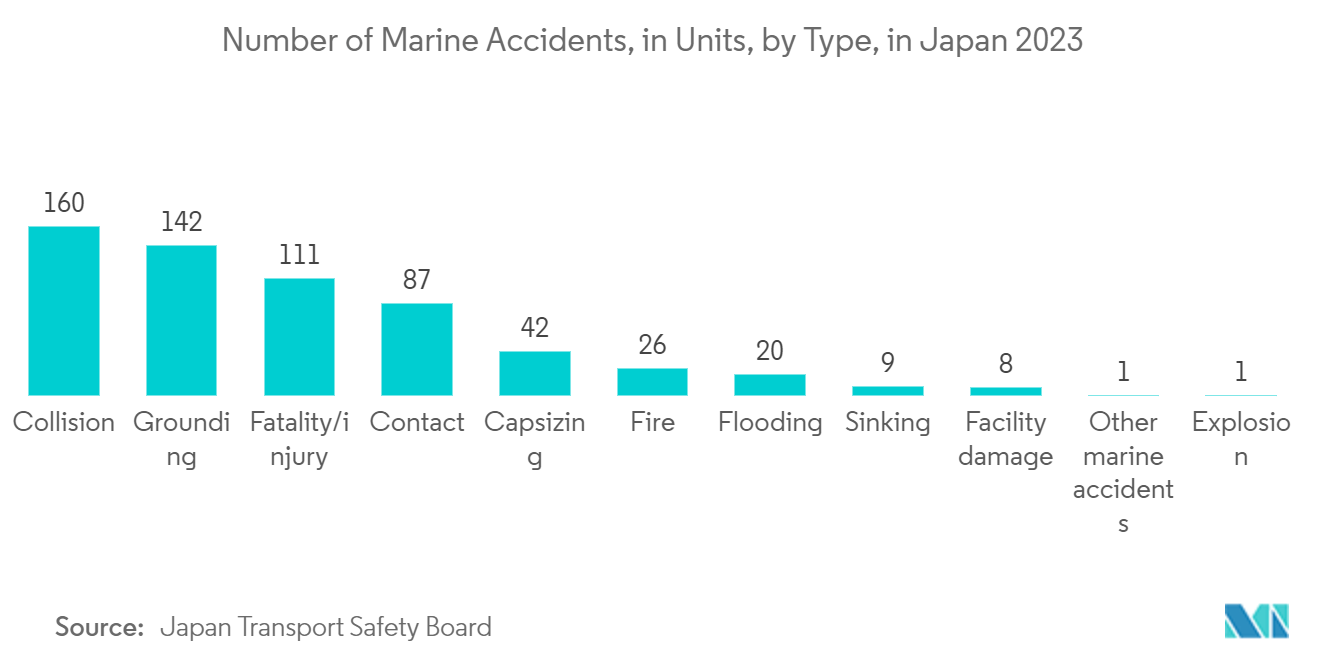
China to Experience Significant Market Growth
- The country's rapid expansion is primarily attributable to the rapidly growing consumer electronics and automobile markets. Furthermore, development in optoelectronic devices is expected in other areas, including smart city initiatives, emerging innovations including virtual and simulated reality, big data, the Internet of Things (IoT), and intelligent industrial appliances.
- The country's growing demand for smart consumer electronics further propels the studied market growth. According to the National Bureau of Statistics of China, the retail trade revenue of household instruments and consumer electronics in China reached CNY 93.79 billion (USD 14.43 billion) in November 2022, an increase from previous months, which recorded CNY 64.61 billion (USD 9.94 billion).
- Moreover, increasing development in the automobile industry in the country is expected to contribute to segment growth over the forecast period. According to the China Association of Automobile Manufacturers(CAAM), in April 2022, approximately 965,000 passenger cars and 216,000 commercial vehicles were sold in China, a slight decrease of 48% and 42% compared to the previous month. Further, it is forecasted to increase in the projection period.
- Furthermore, various market players are investing in manufacturing innovative products in the studied market, which may further drive the country's growth in optoelectronics. For instance, in September 2022, GaNo Optoelectronics Inc., a spin-off from Nanjing University in China that delivers ultraviolet (UV) detectors and modules centered on wide-bandgap semiconductors such as gallium nitride (GaN) and silicon carbide (SiC), officially launched the first commercialized SiC based extreme ultraviolet (EUV) photodiodes.
- In addition, in July 2022, Nationstar Optoelectronics, based in China, established a formal partnership agreement with Huawei to fabricate mini-LED and micro-LED display technology. The partnership is founded on complementary advantages, reciprocal benefits, and joint development principles. It will focus on both groups' fundamental technology and industrial resources. The two firms desire to conduct extensive innovation and analysis to broaden their potential economic coverage.
- Moreover, China has made considerable investments in the digital transformation of its cities. With its top-down approach to urban expansion, the country has effectively mobilized its enterprises and resources to assist its national aim of constructing smart cities. China has created smart city infrastructure that has already been applied to many of its main metropolises and sectors via public-private partnerships and the promotion of focused technical innovation. Such expansion of smart cities across the country may further propel the studied market growth.
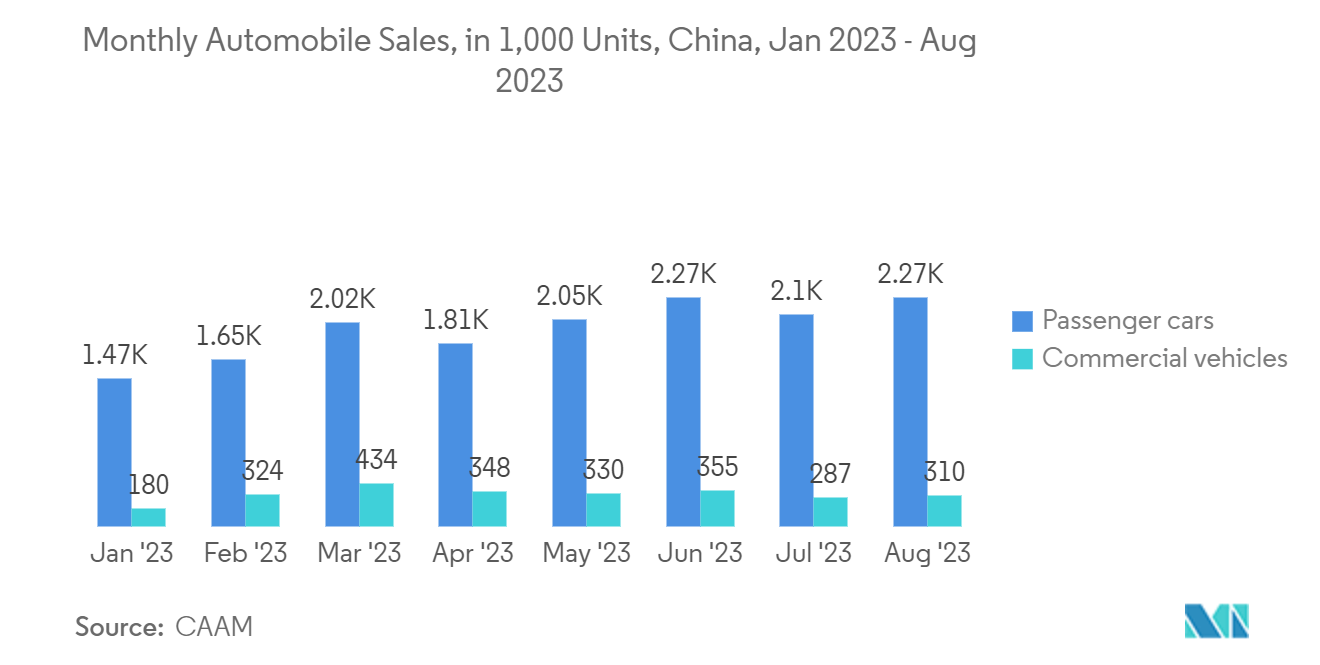
Competitive Landscape
Asia-Pacific Optoelectronics Market is significantly competitive with major players such as Panasonic Corporation, General Electric Company, Omnivision Technologies Inc., Samsung Electronics, and Sony Corporation. Their ability to innovate their products and hefty research and development investments have given them a competitive advantage. Strategic partnerships, mergers, and acquisitions have allowed the companies to maintain a strong foothold in the market.
In March 2022, Nisshinbo Micro Devices Inc. completed the development of the NJL5830R reflective-type optoelectronic sensor for touchless pushbuttons and began production in April 2022. The NJL5830R is a reflecting optoelectronic sensor that combines a high-power infrared LED and a reception photo IC in a single package. This solution will aid in infection management and hygiene by selecting buttons on extremely public infrastructure, such as touchless automatic vending machines, ticket dispensing machines, and lifts.
In February 2022, Bolite Optoelectronics, a Taiwan-based provider of laser micromachining subsystems and equipment, announced the release of its new automatic side-wiring system, the laser-based Bolite SW-L, which can be used to manufacture tiled microLED displays. This laser-based equipment is automated with autonomous handling and provides high-precision alignment and complex production control. 5 um is the smallest line width and spacing.
Asia-Pacific Optoelectronics Industry Leaders
General Electric Company
Panasonic Corporation
Samsung Electronics
Omnivision Technologies Inc
Sony Corporation
- *Disclaimer: Major Players sorted in no particular order
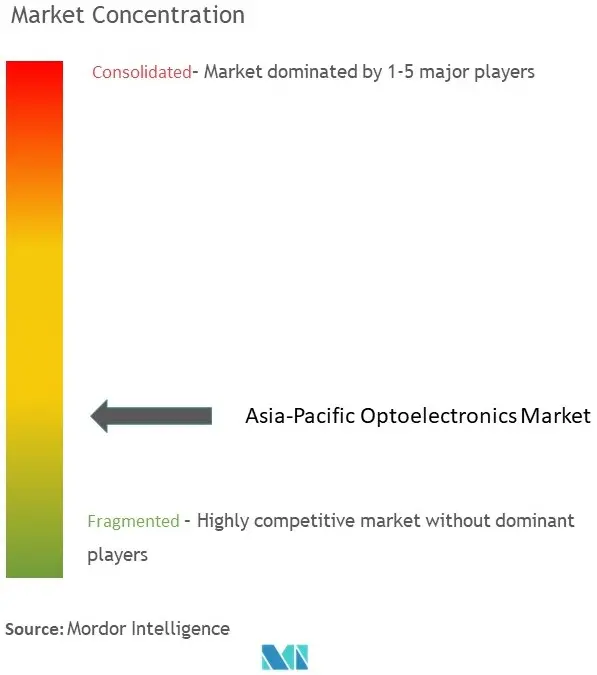
Recent Industry Developments
- March 2023: Onsemi recently announced a unique, innovative image sensor, the AR0822. The device's embedded high dynamic range feature and optimized near-infrared response are necessary for applications with tricky lighting conditions, such as security and surveillance, doorbell cameras, body cameras, and robotics. The sensor's low-power architecture and Wake-on-Motion elements are designed to reduce system power significantly.
- January 2023: IPG Photonics Corporation, the world's significant player in fiber laser technology, announced the launch of six high-efficiency diode laser solutions delivering numerous advantages over thermal ovens in industrial heating and drying applications.
- January 2023: Samsung Electronics announced its latest 200-megapixel (MP) image sensor, the ISOCELL HP2, with improved pixel technology and full-well capacity for stunning mobile images in future premium smartphones. The ISOCELL HP2 packs 200 million 0.6-micrometer (μm) pixels in a 1/1.3 optical format, a sensor size widely operated in 108MP main smartphone cameras. This allows consumers to enjoy even higher resolutions in the latest high-end smartphones without bigger camera bumps.
Asia-Pacific Optoelectronics Market Report Scope
Optoelectronics is based on the quantum mechanical results of light on electronic fabrics, especially semiconductors. Further, it is an emerging technology that incorporates the physics of rays with electricity so that one can control the other. Generally, it is in products like LED lights, solar cells, and optical fiber cables.
The studied market is segmented by component types such as LED, laser diode, image sensors, optocouplers, and photovoltaic cells among various end-user industries such as automotive, aerospace & defense, consumer electronics, information technology, healthcare, residential and commercial, and industrial in multiple countries, such as China, Japan, India, Korea, and the Rest of Asia-Pacific.
The report offers market forecasts and size in value (USD) for all the above segments.
| LED |
| Laser Diode |
| Image Sensors |
| Optocouplers |
| Photovoltaic cells |
| Other Component Types |
| Automotive |
| Aerospace & Defense |
| Consumer Electronics |
| Information Technology |
| Healthcare |
| Residential and Commercial |
| Industrial |
| Other End-User Industries |
| China |
| Japan |
| India |
| South Korea |
| By Component type | LED |
| Laser Diode | |
| Image Sensors | |
| Optocouplers | |
| Photovoltaic cells | |
| Other Component Types | |
| By End User Industry | Automotive |
| Aerospace & Defense | |
| Consumer Electronics | |
| Information Technology | |
| Healthcare | |
| Residential and Commercial | |
| Industrial | |
| Other End-User Industries | |
| By Geography | China |
| Japan | |
| India | |
| South Korea |
Key Questions Answered in the Report
How big is the Asia-Pacific Optoelectronics Market?
The Asia-Pacific Optoelectronics Market size is expected to reach USD 40.03 billion in 2025 and grow at a CAGR of 11.20% to reach USD 68.07 billion by 2030.
What is the current Asia-Pacific Optoelectronics Market size?
In 2025, the Asia-Pacific Optoelectronics Market size is expected to reach USD 40.03 billion.
Who are the key players in Asia-Pacific Optoelectronics Market?
General Electric Company, Panasonic Corporation, Samsung Electronics, Omnivision Technologies Inc and Sony Corporation are the major companies operating in the Asia-Pacific Optoelectronics Market.
What years does this Asia-Pacific Optoelectronics Market cover, and what was the market size in 2024?
In 2024, the Asia-Pacific Optoelectronics Market size was estimated at USD 35.55 billion. The report covers the Asia-Pacific Optoelectronics Market historical market size for years: 2019, 2020, 2021, 2022, 2023 and 2024. The report also forecasts the Asia-Pacific Optoelectronics Market size for years: 2025, 2026, 2027, 2028, 2029 and 2030.
Page last updated on:
Asia-Pacific Optoelectronics Market Report
Statistics for the 2025 Asia-Pacific Optoelectronics market share, size and revenue growth rate, created by Mordor Intelligence™ Industry Reports. Asia-Pacific Optoelectronics analysis includes a market forecast outlook for 2025 to 2030 and historical overview. Get a sample of this industry analysis as a free report PDF download.
